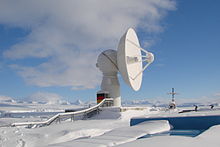GARS-O'Higgins
Coordinates: 63 ° 19 ′ 15.2 ″ S , 57 ° 54 ′ 3.4 ″ W.
GARS O'Higgins (German Antarctic Receiving Station) is a German, polar research station in the Antarctic .
It is located on Cape Legoupil on the Antarctic Peninsula on the six hectare Islote Isabel Riquelme , also known as the Schmidt Peninsula . The island is 300 m wide and 200 m long and is 50 m from the mainland. When the tide is low, there is a land connection to the mainland - hence both the name Islote (Spanish: small island) and Península (Spanish: peninsula).
The station stands on rock and thus offers favorable conditions for long-term geodetic observations. The living, sleeping and working rooms of the campaign teams as well as most of the station technology are located in a main station building consisting of fifteen 20-foot ISO containers and an infrastructure complex consisting of twenty 20-foot ISO containers.
Station operation and areas of responsibility
The research station is operated by the German Aerospace Center (DLR) and the Federal Agency for Cartography and Geodesy (BKG). Campaign teams have been on site all year round since the beginning of 2010. A maximum of ten scientists, engineers and technicians work at GARS O'Higgins. The station is operated in close cooperation with Chile . DLR owns the station and is responsible for satellite operations, management, infrastructure and logistics. All logistical activities are coordinated between DLR and Instituto Antártico Chileno (INACH) . The responsibility for all geodetic observations lies with the BKG.
Location decision
GARS O'Higgins is named after the Chilean freedom fighter Bernardo O'Higgins and was built in 1990/91 next to the Chilean station Bernardo-O'Higgins-Station , which is operated by the Departamento Antártico del Ejército (DAE) . The location in the immediate vicinity of the Chilean station was chosen for various reasons. These include a cooperation agreement with INACH , the geological conditions that are advantageous for a radio telescope , the satellite visibility in the Antarctic area intended for the reception of various sensor data from the European earth observation satellites ERS-1 and ERS-2 , and the existing Chilean infrastructure and logistics.
Accessibility and logistics
As part of the long-term cooperation with Chile, DLR and BKG can fall back on Chilean Antarctic infrastructure and polar logistics. Using this, GARS O'Higgins can be reached from Punta Arenas via King George Island by ship, plane and helicopter. The provision of flights by the Programa Antártico Brasileiro (PROANTAR) is also very important logistically .
Airway
O'Higgins ( ICAO code : SCBO) can be reached all year round using special polar aircraft. If necessary, a 1000 m long runway will be prepared 3 km southeast of the station on the glacier (mainland) and can be approached from King George Island by a DHC-6 Twin Otter of the Fuerza Aérea de Chile (FACh) with runners . The preparation of the runway and the skidoo transfer of people and cargo to and from the runway is carried out by the Ejército de Chile team at the General Bernardo O'Higgins station. In exceptional cases , the FACh also uses a Bell 412 helicopter between King George Island and the Península Schmidt . King George Island , specifically the Chilean airfield Teniente Rodolfo Marsh Martin (ICAO code: SCRM), is transported from Punta Arenas several times all year round by Hercules C-130 transport machines from FACh , Força Aérea Brasileira (FAB) and Fuerza Aérea Uruguaya (FAU ) approached. On this route flying FAB in PROANTAR -Order and the FAU on behalf of the Uruguayan Antarctic Institute (IAU) . During the southern summer, the private airline Aerovías DAP also operates commercial flights between Punta Arenas and King George Island .
Waterway
Depending on the sea ice and iceberg situation, ships O'Higgins also call at in southern summer. In particular, the supply of the station with marine diesel oil (MDO), the transport of containers and general cargo to and from the station and, in some cases, the exchange of people are carried out by the Armada de Chile using the ships ATF Lautaro and Almirante Oscar Viel . Due to the shallow water around the Schmidt Peninsula , ships cannot dock directly at the pier. If the sea allows it, people and smaller cargo are therefore transported by rubber dinghy between the ship and the station. For the same reason, containers are brought to or from the station by the Almirante Oscar Viel by self-propelled barge (pontoon with its own propulsion) . The Almirante Oscar Viel can also fly people and smaller cargo to and from the ship with the BO-105 helicopter. This often happens when the sea ice conditions do not allow the use of rubber boats.
research
Scientific equipment of the station
The most important scientific instrument of the German Antarctic station is a 9-meter antenna that is used both for receiving satellite data and commanding satellites and as a radio telescope. The antenna and the associated technology were installed in the southern summer of 1990/91. The first experiments were carried out in 1991. The 9 meter antenna was specially designed for use under extreme Antarctic conditions. Storms with wind peaks of up to 180 km / h are no problem for the operational antenna operation. Other important scientific instruments are permanent GPS , GLONASS & GALILEO reference stations. In addition to a pressure level, the station has a radar level. The radar level provides absolute, GPS-referenced sea level data. Absolute gravimeter measurements were carried out repeatedly . Two weather stations continuously record meteorological measurements such as temperature, relative humidity, air pressure, wind direction and wind speed.
Satellite operation and earth observation
From 1991 until the end of the mission on July 4, 2011, SAR data and other sensor data from the European earth observation satellites ERS-1 and ERS-2 were received in GARS O'Higgins. The operation of the SAR satellite TSX has been supported by the German earth observation mission TerraSAR-X since 2007 . With the launch of the almost identical SAR twin satellite TDX on June 21, 2010, GARS O'Higgins took on a decisive role in the implementation of the German TanDEM-X mission. GARS O'Higgins covers a large part of the data reception and enables - along with other DLR ground stations - the monitoring and command of the satellites TSX and TDX, which form the satellite-based radar interferometer TanDEM-X. The GARS O'Higgins station is becoming increasingly important for the GRACE mission, which DLR and NASA agreed to continue until 2015 .
Geodesy and Astrometry
Used as a radio telescope, the 9-meter antenna receives signals from radio stars and is used to carry out geodetic VLBI observations . In this capacity, GARS O'Higgins is a network component of the International VLBI Service (IVS). VLBI observations provide precise data on continental drift , among other things . In the implementation of the International Celestial Reference System (ICRS) and the derivation of the Earth's rotation parameters (ERP), GARS O'Higgins largely determines the achievable accuracy. The station is of unique importance for radio astrometry due to its location on the Antarctic Peninsula. The TANAMI project ( Tracking Active Galactic Nuclei with Austral Milliarcsecond Interferometry ) has shown this impressively. In the TANAMI project, black holes are observed in the centers of distant galaxies that are millions to billions of times heavier than our sun. With the integration of the radio telescope in GARS O'Higgins, a new VLBI image of Centaurus A Jet structures only 0.04 light years in size was able to be shown. This represents a new record in extragalactic black hole exploration that would not have been possible without GARS O'Higgins.
Web links
- BKG satellite image map of the Antarctic Peninsula, scale 1: 250,000, SP 21-22 / 13 Trinity Peninsula, 1996: Link and PDF
- DLR News (December 2011): 20 years of O'Higgins Antarctic Station: Working on the White Continent
- DLR Communication Blog (December 2011): 20 years of GARS O'Higgins: Two weeks in Chile in special memory
Individual evidence
- ↑ a b c d DLR Magazin 132 (November 2011), pages 54–59: And every day the penguin says hello - 20 years of the DLR Antarctic station GARS O'Higgins (PDF; 12.2 MB)
- ↑ a b c d Brochure The Federal Government: German Commitment to the White Continent, Antarctic Treaty - 30 Years of Consultative Status , pages 22–23 (PDF; 3.3 MB)
- ↑ German Embassy Santiago de Chile (November 2011): Delegación del Centro Alemán Aeroespacial viajó a Punta Arenas para conmemorar 20 años en la cooperación chileno-alemana en la estación antártica GARS-O'Higgins ( Memento from December 27, 2012 in the Internet Archive )
- ↑ INACH News (November 2011): Expertos antárticos de Europa y América se reúnen en Punta Arenas
- ↑ Armada de Chile News (November 2011): Armada participa en el 20º aniversario de la Estación Antártica de Alemania ( Memento of January 7, 2014 in the Internet Archive )
- ↑ SCAR / Russia Gazetteer Id 118141: General Bernardo O'Higgins
- ↑ Polarforschung 67 (112), pages 3–6, 1997 (published 2000): The German Antarctic Receiving Station within the International Ground Segment for Remote Sensing (PDF; 1.5 MB)
- ↑ INACH: Operaciones Logisticas
- ↑ a b ICAO Doc 7910, Location Indicators, ISBN 978-92-9231-622-8 , pages 4-55 & 4-56
- ↑ DGAC IFIS: Aeródromo: Teniente Rodolfo Marsh Martin (SCRM)
- ↑ Armada de Chile: AP-46 Almirante Oscar Viel
- ↑ International GNSS Service (IGS): Site OHI2 ( memento of June 26, 2009 in the Internet Archive ) and Site OHI3 ( memento of March 8, 2016 in the Internet Archive )
- ↑ DLR EOC News (July 2011): The end of an era - ERS-2 is retiring after 16 years
- ↑ DLR Earth observation: TerraSAR-X - Germany's radar eye in space
- ↑ DLR Earth observation: TanDEM-X - The earth in three dimensions
- ↑ DLR News (June 2010): GRACE mission extended until 2015: NASA and DLR sign contract on ILA
- ↑ International VLBI Service for Geodesy & Astrometry (IVS): Network Stations
- ↑ 20 Years Antarctic Research Station GARS O'Higgins, Symposium 12-15 November 2011, Punta Arenas: Geodetic VLBI at O'Higgins station and the next generation VLBI system ( Memento from February 15, 2015 in the Internet Archive ) (PDF; 4, 1 MB)
- ↑ scinexx - The Knowledge Magazine (May 2011): A sharp look at the jets of a black hole succeeded
- ↑ NASA News (May 2011): Radio Telescopes Capture Best-Ever Snapshot of Black Hole Jets
- ↑ Dual-frequency VLBI study of Centaurus A on sub-parsec scales - The highest-resolution view of an extragalactic jet. In: Astronomy & Astrophysics , Volume 530, June 2011, L11. doi : 10.1051 / 0004-6361 / 201116605 .



